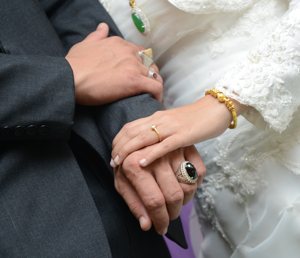
Over the years, as I have assisted couples preparing for their wedding liturgy, I have observed that the most chosen wedding Gospels by engaged couples are two parallel texts in Matthew 19:3-6 and Mark 10:6-9, and for good reason.
In these texts Jesus explains his ideals for marriage. Moses taught that divorce was allowable (Dt 24:1; Mt 19:7; Mk 10:4), but Jesus taught that marriage is to be permanent, “What God has joined together, no human being must separate” (Mt 19:6; Mk 10:9; see Gn 2:24). Furthermore, ancient society was thoroughly patriarchal, holding that men are superior to women and everyone else. But Jesus taught that “the two become one flesh” (Mt 19:5; Mk 10:8), and if wife and husband are made of the same flesh (see Gn 2:21-23), identically the same substance, one is not better than the other. They are the same — equal.
Ancient society had a definite pecking order. It was a caste system. There were four rungs or tiers on the social ladder. Men were on the top rung. Women were on the second. Children were on the third. Slaves were on the fourth.
And there was a property right. Men were privileged and superior to women. A husband exercised a property right over his wife; he owned his wife, and she was his possession, a thing. A husband and wife were superior to their children, and together they exercised a property right over their children; the parents owned their children. And finally, a free family was superior to their slaves, and they exercised a property right over them; they owned their slaves.
Jesus rejected this social hierarchy. According to Jesus, no person or social caste is automatically better than someone else, and no one owns another person. Women, who were oppressed, disregarded, mistreated, demeaned, exploited and used in ancient culture, were overjoyed with Jesus’ countercultural Gospel message. In their society and religion, women were supposed to be subservient to men, but Jesus would have none of this. Jesus had a better way. Jesus wants wives and husbands to be equal partners in marriage. In those days no one spoke like this. The teachings of Jesus were new, exciting, encouraging and empowering for women, and a challenge to men’s understanding of their relationships with others.
Sometimes people sidestep Jesus’ radical new approach, quoting St. Paul who wrote, “Wives should be subordinate to their husbands” (Eph 5:22), as if a husband should be the head of his wife, his children, and his home, and continue the patriarchy of ancient times. But this takes St. Paul out of context. St. Paul also wrote that husbands and wives should “Be subordinate to one another” (Eph 5:21a). There is no patriarchy in subordinating oneself to one’s spouse; only mutual respect, concern and equality.
St. Paul continues, “The husband is the head of his wife just as Christ is head of the church” (Eph 5:23). Jesus, as head of the Church, gave his life for the Church (see Jn 15:13; 19:30), and a husband should give his life for his wife, and conversely, a wife should give her life for her husband. Jesus had authority and power, and he used it to love and serve others. Whatever authority and power a husband may have, it is to love and serve his wife, and conversely, whatever power and authority a wife may have, it is to love and serve her husband. Neither is above or below the other. Husbands and wives are equals, coleaders of the home and their children. Jesus leveled the playing field. Jesus wants marriage to be a loving partnership of equals.
Father Van Sloun is the director of clergy personnel for the Archdiocese of St. Paul and Minneapolis. This column is the last of 28 in a series on the sacrament of marriage. The next series on the seven sacraments will address holy orders, beginning in October. Past series on the sacraments by Father Van Sloun provided catechesis on the Eucharist and confirmation. All of the columns can be found here.




